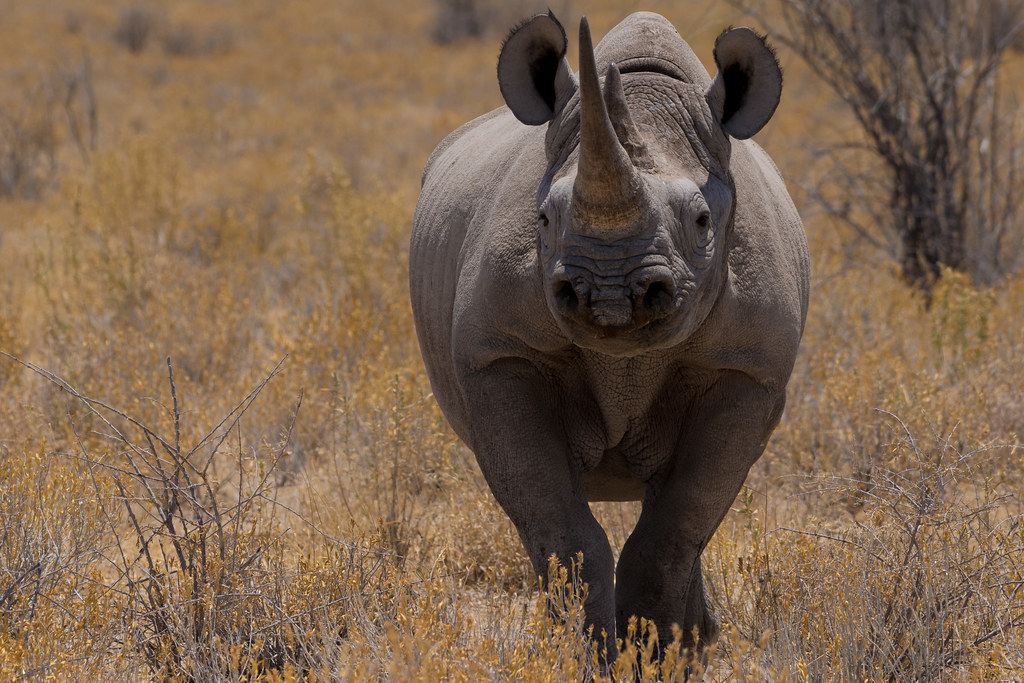環境資訊中心外電;姜唯 翻譯;林大利 審校;稿源:ENS
美國杜克大學(Duke University)開發出一款可以讀取和分析黑犀牛(Black rhinoceros,學名:Diceros bicornis)腳印的互動軟體,能用來監視瀕危動物的野外活動,阻絕盜獵者下手機會。
這套「」(Footprint Identification Technique, FIT)軟體可在美國分析軟體公司SAS的JMP統計軟體上運作,使用高階演算法分析100多頭犀牛腳印的特徵測量值。
納米比亞黑犀牛。照片來源: (CC BY-NC-ND 2.0)
FIT可避免人與犀牛接觸 保護雙方免於病毒感染
犀牛的腳印跟人類的指紋一樣獨特,因此可將分析後的圖像儲存在過去收集的全球腳印資料庫中進行比對。
「比對成功便能識別出留下腳印的動物,並把牠的腳印出現處畫成分布圖,追蹤其移動路徑,不需打擾牠或與之接觸。」杜克大學尼古拉斯環境學院兼任副教授說,接觸可能會導致動物將病毒傳播給人類。
傑威爾也是SAS研究所JMP部門的首席研究員,這項研究的共同主持人,FIT的共同開發者。傑威爾說:「這個方法經濟有效,不僅可以保護犀牛和人類的健康,還可以將具有數百年歷史的追蹤技術帶進21世紀。」
傑威爾和同事現在正與納米比亞環境、林業和旅遊部合作,培訓野生動物保護工作者、土地管理人員、當地嚮導和反盜獵人員使用FIT。這份同儕審查研究於8月14日發表於開放期刊《》。
犀牛腳印獨特,可透過演算法個別分析追蹤。照片來源: (CC BY-NC-ND 2.0)
納米比亞2000頭黑犀牛 每年約有50頭遭盜獵
納米比亞大約有2000頭黑犀牛,約佔該物種總個體數的90%。雖然這些動物屬於政府所有,但牠們分散在全國的私人土地上。
納米比亞埃托沙國家公園(Etosha National Park)的工作人員解釋,納米比亞的黑犀牛是獨一無二的,即使在惡劣的沙漠景觀中也能繁殖。牠們已經進化成可以在沒有水的情況下存活數天。在長期乾旱時,牠們所食用的植物會產生有毒化學物質,而黑犀牛對此竟也產生抵抗力。納米比亞黑犀牛的出沒範圍也比其他黑犀牛物種大得多。
近年來政府加強警務,已經降低了因盜獵所致的黑犀牛消失速度,但每年仍有30至50頭黑犀牛被殺。
納米比亞埃托沙國家公園一頭黑犀牛。照片來源: (CC BY-ND 2.0)
由角蛋白製成的犀牛角成分跟人的頭髮和指甲無異,沒有藥效,但它們在亞洲黑市上的售價為每公斤超過6萬美元,被當作傳統醫學材料,或財富和成功的象徵。
「黑犀牛的角價值超過10萬美元。當牠們進入納米比亞的偏遠地區,便成為盜獵者難以抗拒的目標。當局常常要在發現黑犀牛的骨頭或屍體,才知道被盜獵了。」傑威爾說。
FIT能估算區域內犀牛數量 節省巡邏車資源
非洲黑犀牛分布在非洲東部沿海與納米比亞。圖片來源:
傑威爾說,FIT可以用3種不同的方式監測動物,讓科學家、管理人員、嚮導或反盜獵巡邏隊都可以依自身需求使用。FIT的簡配可以用來將野外發現的腳印時與FIT資料庫比對。
FIT還可以調查整個保護區的腳印,並從每張腳印圖片中進行測量,以估算該區域內的犀牛數量。這對於計算巡邏車等資源需求來說相當實用。
FIT全配版可以追蹤特定犀牛個體,將個體與其獨特的腳印配對。反盜獵巡邏隊可以用這個互動的資料庫搜索風險最高的個體,像是經常出沒危險地區或是好幾年都沒看到的個體。
黑犀牛(Black rhinoceros)
黑犀牛是犀科黑犀屬的唯一一種,原生於非洲肯亞、坦尚尼亞、喀麥隆、南非、納米比亞和辛巴威,最重可達1820公斤。黑犀牛目前包括4個亞種,被國際自然保護聯盟(IUCN)列爲「極危」(Critically Endangered)。 黑犀牛在20世紀曾是所有犀牛中數量最多的一種,但由於辛巴威盜獵嚴重,在20世紀後半葉,黑犀的數量急遽下降,從7萬頭下降到1981年的1萬到1萬5000頭。1990年左右數量又降到2500頭以下。根據2003年資料顯示,黑犀牛的數量已有回升,約3610頭。黑犀牛減少的原因主要是盜獵和棲息地破壞。 資料來源: Software Foils Poachers With Rare Rhinos’ Footprints DURHAM, North Carolina, September 14, 2020 (ENS)
Interactive software that reads and analyzes footprints left by black rhinoceroses can be used to monitor the movements of the critically endangered animals in the wild, giving conservationists a new way to keep watch on the species and help keep them safe from poachers, according to a new Duke University-led study.
The software called the Footprint Identification Technique, or FIT, runs on JMP software from SAS Institute. JMP is a suite of computer programs for statistical analysis developed by the JMP business unit of the SAS Institute, an American multinational developer of analytics software based in Cary, North Carolina.
The software uses advanced algorithms to analyze more than 100 measurements of a rhino’s footprint.
Because each rhino’s footprint is as distinctive as a human fingerprint, the analyzed images can be archived electronically in a global database of previously collected footprint images for matching.
“If you find a match, you can identify the individual animal who left the mark and, by plotting the locations of all the other places that mark has been seen, track its movements without disturbing it or coming into close enough contact with it for there to be a risk of animal-to-human viral transmissions,” said Zoe Jewell, adjunct associate professor at Duke University’s Nicholas School of the Environment.
Jewell is also a principal research associate at the JMP Division of the SAS Institute. She co-led the study and is co-creator of the Footprint Identification Technique.
“It’s a cost-effective approach that not only protects the health of the rhino and the human but also brings a centuries-old tracking skill into the 21st Century,” she said.
Jewell and her colleagues are now working with Namibia’s Ministry of Environment, Forestry and Tourism to train wildlife conservationists, land managers, local guides and anti-poaching agents how to use FIT.
The scientists published their peer-reviewed study describing the technology’s effectiveness for monitoring the endangered rhinos on August 14 in the open-access journal “PeerJ.”
Namibia is home to an estimated 2,000 black rhinos or about 90 percent of the species’ total population worldwide. Though legally owned by the government, the animals are dispersed geographically on private lands across the country.
The black rhinos of Namibia are unique, thriving even in a harsh, desert-like landscape, explain staff members at Namibia’s Etosha National Park. They have evolved to survive without water for several days and have even developed a resistance to the toxic chemicals in the plants that they depend on for survival during long droughts. They also have much bigger ranges than other species of black rhino.
Stepped up government policing in recent years has slowed the rate of loss due to poaching, but between 30 and 50 rhinos are still slain each year for their horns.
Rhino horns, made of keratin like human hair and fingernails, have no medicinal powers but they can sell for more than US$60,000 a kilogram on the Asian black market, where they are used in traditional medicine or displayed as a symbol of wealth and success.
“You essentially have these animals with horns worth $100,000 or more that disappear from sight into the Namibian backcountry, making them an almost irresistible target for poachers. Authorities often don’t know a missing rhino has been poached until they find its bones or carcass,” said Jewell.
FIT allows the animals to be monitored three different ways, allowing scientists, managers, guides or anti-poaching patrols to use the software as best meets their individual needs and constraints, she said.
In the simplest option, the heel pattern on a digital image of the footprint is compared to images already in the FIT database to search for a match. This use is well-suited to situations where a random footprint is found in the wild.
The FIT software can also do a survey of footprints throughout the protected area and take measurements from each print to estimate the number of rhinos in that area. This can be useful information for calculating resource needs, the number of patrol vehicles, for instance, to monitor the animals effectively.
In the most advanced option, each individual rhino can be tracked and matched to its unique footprint using both FIT and heel-patterns. This creates an interactive library that anti-poaching patrols can use to search for animals at the highest risk, including those known to frequent areas under threat from poachers or those whose footprints haven’t been showing up in recent years.
※ 全文及圖片詳見:
作者
如果有一件事是重要的,如果能為孩子實現一個願望,那就是人類與大自然和諧共存。
於特有生物研究保育中心服務,小鳥和棲地是主要的研究對象。是龜毛的讀者,認為龜毛是探索世界的美德。
延伸閱讀
【其他文章推薦】
※有廠商專門客製化橡膠製品嗎?
※噴霧洗滌塔實際應用案例分享
※票選推薦煮婦最愛手壓封口機,省荷包不犧牲品質
※選購空壓機需注意八大事項 !
※DIY自行施工隔熱紙,簡易教學大公開 !
※選擇好的茶葉罐,有效地保持茶葉的鮮度與風味!
※單螺及雙螺杆泵優劣解析
